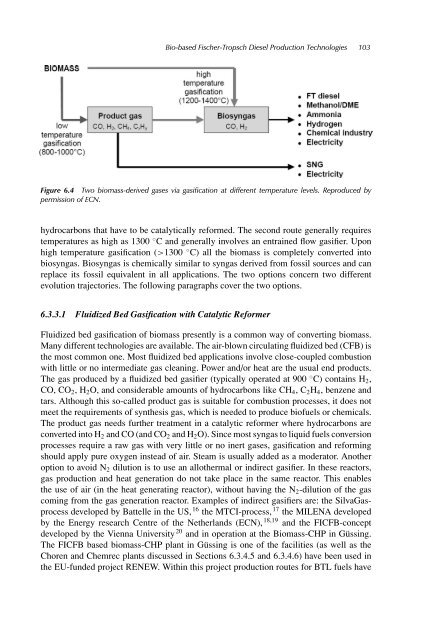Biofuels in Perspective
Biofuels in Perspective
Biofuels in Perspective
You also want an ePaper? Increase the reach of your titles
YUMPU automatically turns print PDFs into web optimized ePapers that Google loves.
Bio-based Fischer-Tropsch Diesel Production Technologies 103<br />
Figure 6.4 Two biomass-derived gases via gasification at different temperature levels. Reproduced by<br />
permission of ECN.<br />
hydrocarbons that have to be catalytically reformed. The second route generally requires<br />
temperatures as high as 1300 ◦ C and generally <strong>in</strong>volves an entra<strong>in</strong>ed flow gasifier. Upon<br />
high temperature gasification (>1300 ◦ C) all the biomass is completely converted <strong>in</strong>to<br />
biosyngas. Biosyngas is chemically similar to syngas derived from fossil sources and can<br />
replace its fossil equivalent <strong>in</strong> all applications. The two options concern two different<br />
evolution trajectories. The follow<strong>in</strong>g paragraphs cover the two options.<br />
6.3.3.1 Fluidized Bed Gasification with Catalytic Reformer<br />
Fluidized bed gasification of biomass presently is a common way of convert<strong>in</strong>g biomass.<br />
Many different technologies are available. The air-blown circulat<strong>in</strong>g fluidized bed (CFB) is<br />
the most common one. Most fluidized bed applications <strong>in</strong>volve close-coupled combustion<br />
with little or no <strong>in</strong>termediate gas clean<strong>in</strong>g. Power and/or heat are the usual end products.<br />
The gas produced by a fluidized bed gasifier (typically operated at 900 ◦ C) conta<strong>in</strong>s H2,<br />
CO, CO2, H2O, and considerable amounts of hydrocarbons like CH4, C2H4, benzene and<br />
tars. Although this so-called product gas is suitable for combustion processes, it does not<br />
meet the requirements of synthesis gas, which is needed to produce biofuels or chemicals.<br />
The product gas needs further treatment <strong>in</strong> a catalytic reformer where hydrocarbons are<br />
converted <strong>in</strong>to H2 and CO (and CO2 and H2O). S<strong>in</strong>ce most syngas to liquid fuels conversion<br />
processes require a raw gas with very little or no <strong>in</strong>ert gases, gasification and reform<strong>in</strong>g<br />
should apply pure oxygen <strong>in</strong>stead of air. Steam is usually added as a moderator. Another<br />
option to avoid N2 dilution is to use an allothermal or <strong>in</strong>direct gasifier. In these reactors,<br />
gas production and heat generation do not take place <strong>in</strong> the same reactor. This enables<br />
the use of air (<strong>in</strong> the heat generat<strong>in</strong>g reactor), without hav<strong>in</strong>g the N2-dilution of the gas<br />
com<strong>in</strong>g from the gas generation reactor. Examples of <strong>in</strong>direct gasifiers are: the SilvaGasprocess<br />
developed by Battelle <strong>in</strong> the US, 16 the MTCI-process, 17 the MILENA developed<br />
by the Energy research Centre of the Netherlands (ECN), 18,19 and the FICFB-concept<br />
developed by the Vienna University 20 and <strong>in</strong> operation at the Biomass-CHP <strong>in</strong> Güss<strong>in</strong>g.<br />
The FICFB based biomass-CHP plant <strong>in</strong> Güss<strong>in</strong>g is one of the facilities (as well as the<br />
Choren and Chemrec plants discussed <strong>in</strong> Sections 6.3.4.5 and 6.3.4.6) have been used <strong>in</strong><br />
the EU-funded project RENEW. With<strong>in</strong> this project production routes for BTL fuels have








